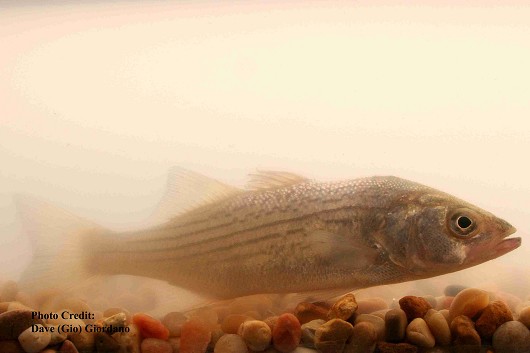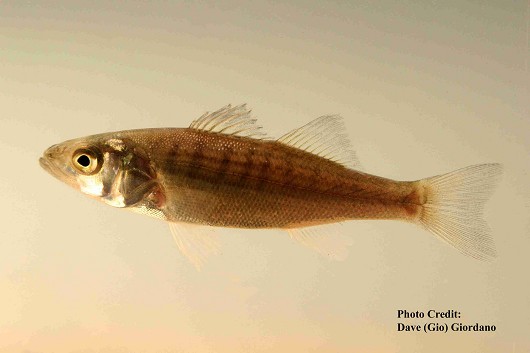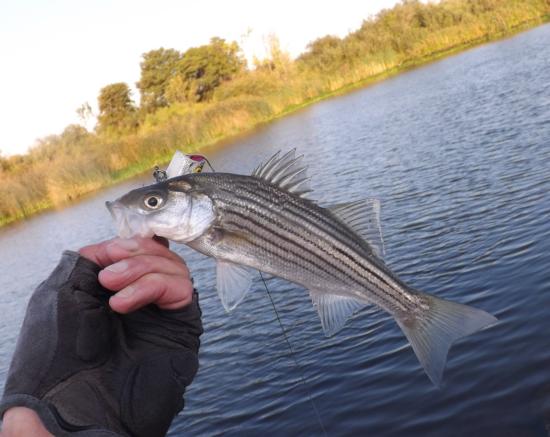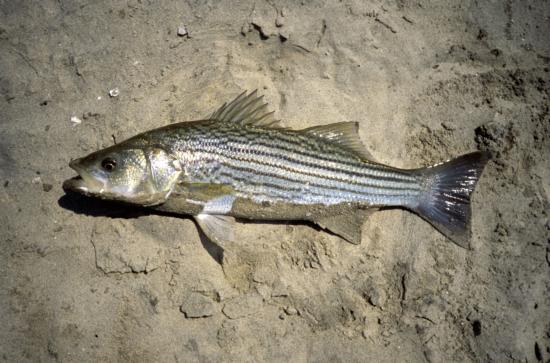Striped Bass
-
Scientific NameMorone saxatilis
-
NativeNo
-
Identification
 Striped bass, approximately 18 cm (7”) long. Location: Suisun Marsh, California Date: 8/6/2007.
Striped bass, approximately 18 cm (7”) long. Location: Suisun Marsh, California Date: 8/6/2007. Striped bass, approximately 9 cm (3.5”) long. Location: Suisun Marsh, California Date: 8/6/2007.
Striped bass, approximately 9 cm (3.5”) long. Location: Suisun Marsh, California Date: 8/6/2007. Striped bass caught and released on the South fork Mokelumne River. Photo by Gary Riddle. 7/18/2014.
Striped bass caught and released on the South fork Mokelumne River. Photo by Gary Riddle. 7/18/2014. Striped Bass from Santa Margarita River Lagoon. Photo by Camm C. Swift
Striped Bass from Santa Margarita River Lagoon. Photo by Camm C. Swift- Streamlined body
- Silvery-white body with 6-9 black, horizontal stripes
- Tail pointed at the tips and slightly forked
- Large terminal mouth but the maxillae do not extend past the hind margin of the eye
- 2 distinct dorsal fins, the first with 9-10 spines, and the second with 1-2 spines and 11-12 rays
- Anal fin with 3 spines and 9-11 rays
- Pectoral fin has 13-17 rays
- 53-65 scales along the lateral line
- 2 small but distinct spines on the operculum
-
Life History
Striped Bass move readily between salt and fresh water spending most of their life cycle in estuaries. Temperatures up to 34°C can be withstood for short periods of time, but temperatures greater than 25°C are stressful, and 30°C for longer times is lethal. Adults can also withstand the rapid changes in temperature that come with changes in salinity. Dissolved oxygen levels as low as 3-5 mg/L can also be survived for short periods. Striped Bass need three very specific habitat structures: (1) a large cool river for spawning, with enough flow to keep larvae suspended into the estuary, (2) a large water body with plenty of fish to eat, and (3) a protective estuary for juveniles to grow by feeding on invertebrates. In California the only area that satisfies these criteria is the San Francisco Estuary and its surrounding water bodies. These Striped Bass populations spend the majority of their time in bays, but will move out into ocean during El Nino years, and winter in the Sacramento-San Joaquin Delta until the end of the spawning season. Juveniles feed mainly on invertebrates, especially amphipods and copepods, gradually incorporating more fish in their diet as they get larger. Once they become large enough, Striped Bass are almost entirely piscivorous, and are both voracious and opportunistic. Some individuals have been observed waiting by man-made diversions to ambush juvenile salmon as they come out of the tube that allows passage downstream through the diversion.
Males mature in 2-3 years, females in 4-6 years, and spawning usually begins in April. The exact start of the spawning season varies, however, and is based upon the interactions of temperature, flow, and salinity. When conditions are right, including temperatures between 14°C and 21°C, groups of 5-30 individuals, composed of some females but mostly males, swim to the surface. There the group releases their eggs and milt simultaneously, so that the eggs are fertilized as they float downward. The eggs need to stay suspended in the water column to survive, and therefore hatch quickly (after approximately 48 hours). The larvae will live off their yolk sac for the next 7-8 days as they are pushed by the current downstream to where fresh and brackish water meet. These areas are usually the most productive, resulting in large amounts of zooplankton for the young Striped Bass to eat. Fecundity increases with size, and females as young as 4 years old can produce 243,000 eggs in a season. This number will grow to 1.4 million eggs at age 8 and may reach a maximum of nearly 5 million. Larger females also produce larger eggs with more yolk and oil, leading to a greater rate of survival. Growth is most rapid in the first 4 years, but varies with food availability. On average Striped Bass reach 9-11 cm FL their first year and 44-54 cm FL in their fourth year. Individuals older than 10 years or larger than 85 cm FL are uncommon. The largest individual recorded was 125 cm FL, and some have been found to be more than 30 years old.
Despite the requirements mentioned above, a landlocked population of Striped Bass exists in Millerton Reservoir, spawning in the San Joaquin River and growing at a faster rate (55-56 cm FL by fourth year) than the population in the Sacramento-San Joaquin Delta.
-
Links to Other ResearchN / A



